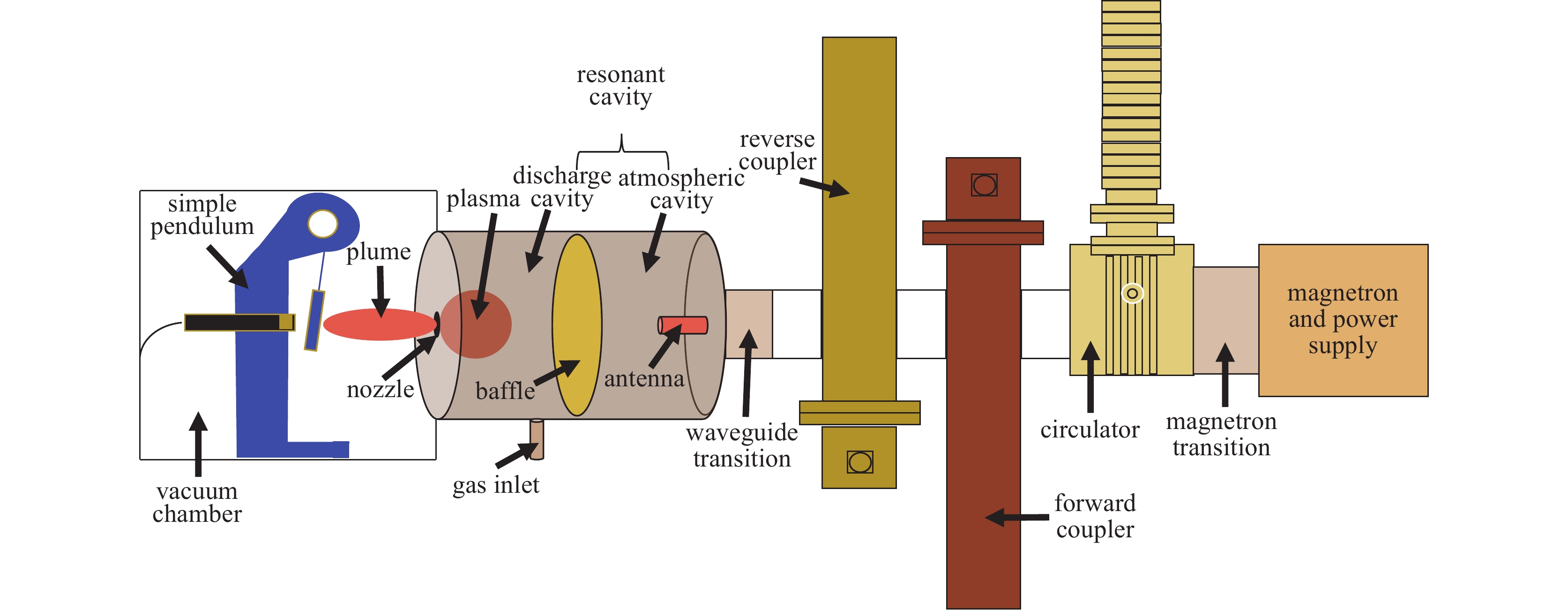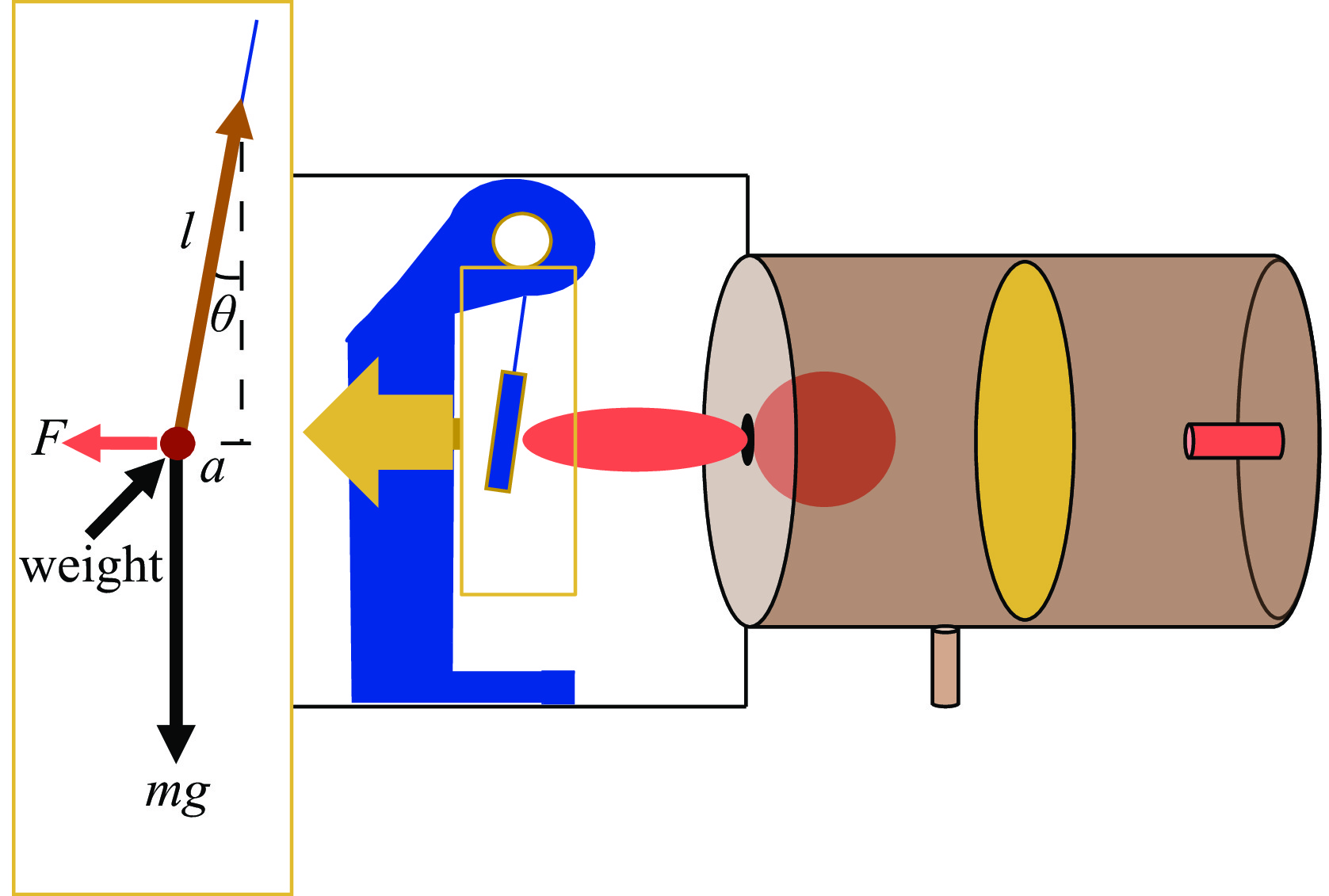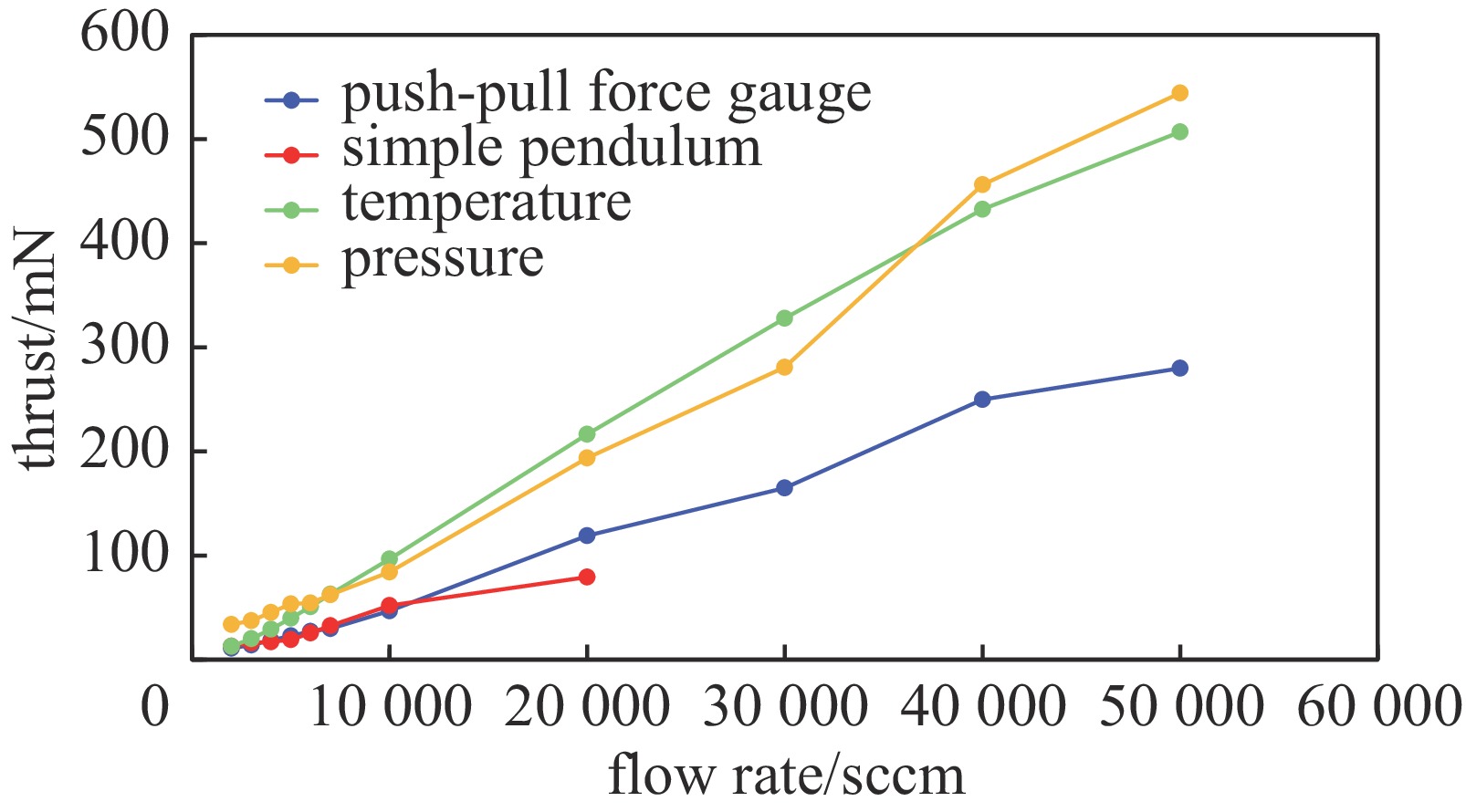Research on micro thrust testing of microwave plasma thruster
-
摘要: 本研究聚焦于微波等离子体推力器在微小卫星应用中的关键测试技术难题。针对实验室真空环境下的空间约束条件,创新性地开发了多种推力测量方案。实验采用1.5 kW功率的2.45 GHz磁控管微波源,通过氦气工质产生等离子体推力。研究重点突破了传统推力测量装置在有限空间内的应用限制,建立了包括直接力学测量和间接参数推算在内的完整测试体系。测试结果表明,在0~600 mN推力范围内,这四种方法在不同工况下均表现出良好的测量效果,且推拉力计和单摆推力计的测量结果高度一致,验证了方法的有效性。此外,基于谐振腔特性的间接计算方法在放电实验中提供了与直接测量相符的推力估计值,进一步证明了其可行性。本研究为微小推力器的地面测试提供了可靠的技术方案,其模块化设计思路特别适合立方星等微小卫星平台的推进系统验证需求。Abstract:
Background With the rapid development of microsatellite platforms such as CubeSats, microwave plasma thrusters have become ideal for orbit maintenance and attitude control due to their high specific impulse, no electrode ablation, compact structure, and flexible working fluid. However, the thrust of such thrusters (at the 1000W power level) is usually in the millinewton range, and its accurate measurement is crucial for performance verification. Existing thrust measurement schemes require at least 50 cm of space, conflicting with the extreme spatial constraint of 18 cm×16 cm in the current laboratory vacuum chamber; traditional indirect measurement also needs 2-3 parameters, increasing experimental complexity.Purpose This study aims to address the spatial limitation of the vacuum chamber, develop miniaturized thrust measurement schemes, establish a complete testing system including direct mechanical measurement and indirect parameter estimation, and verify the effectiveness and feasibility of these methods for ground testing of thrusters.Methods Four thrust measurement methods were developed: 1) Modified NH-2 electronic push-pull force gauge (2 N range, 0.001 N resolution) with a 5.5 cm metal target and 3D-printed bracket; 2) Pendulum thrust meter using an eddy current displacement sensor (2 mV/μm sensitivity) to measure small displacements, with force analysis under small angles (<10°); 3) Thrust calculation based on resonant cavity gas temperature (measured by WRe26 thermocouple, 0-1800 ℃ range) using adiabatic process and ideal gas equations; 4) Thrust calculation based on resonant cavity pressure (measured by a precision pressure gauge) via derived formulas. Experiments used a1500 W 2.45 GHz magnetron microwave source with helium as the working fluid, conducted under cold gas (microwave off) and discharge (microwave on) conditions.Results In cold gas experiments, thrust increased almost linearly with helium flow; push-pull force gauge and pendulum data were highly consistent, while temperature- and pressure-based calculated values were higher. In discharge experiments, thrust still increased with flow (slower at high flow), specific impulse remained stable (slight drop at high flow), and temperature- and pressure-based values showed better consistency. All four methods performed well within the 0-600 mN thrust range, with indirect methods consistent with direct measurements.Conclusions The four methods effectively solve the spatial constraint issue. Direct measurements (push-pull force gauge, pendulum) are effective, and indirect calculations (temperature, pressure) are feasible. The modular design is particularly suitable for CubeSats, providing reliable, low-cost, and easy-to-implement solutions for micro thruster performance verification and optimization, with promising application prospects.-
Key words:
- microwave electric thruster /
- thrust measurement /
- pendulum method /
- thrust gauge /
- plasma
-
-
[1] Abaimov M D, Micci M M, Bilén S G. A 17.8-GHz microwave electrothermal thruster for cubesats and small satellites[C]//Space Propulsion 2016. 2016. [2] Gallucci S E, Micci M M, Bilén S G. Design of a water-propellant 17.8-GHz microwave electrothermal thruster[C]//Presented at the 35th International Electric Propulsion Conference. 2017: 296. [3] Biswas S, Beckerle M, Mcternan J, et al. Thrust Measurements of a 17.8-GHz ammonia microwave electrothermal thruster for small satellites[C]//Presented at the 37th International Electric Propulsion Conference. 2022. [4] Whitehair S, Asmussen J, Nakanishi S. Demonstration of a new electrothermal thruster concept[J]. Applied Physics Letters, 1984, 44(10): 1014-1016. doi: 10.1063/1.94603 [5] Clemens D E, Micci M M, Bilén S G, et al. Evaluation and optimization of an 8-GHz microwave electrothermal thruster[C]//46th AIAA/ASME/SAE/ASEE Joint Propulsion Conference & Exhibit. 2010: 6520. [6] Brandenburg J E, Kline J, Sullivan D. The microwave electro-thermal (MET) thruster using water vapor propellant[J]. IEEE Transactions on Plasma Science, 2005, 33(2): 776-782. doi: 10.1109/TPS.2005.845252 [7] Kamaritis M M E, Biswas S, Bilén S G. 30-GHz proof-of-concept microwave electrothermal thruster[C]//Presented at the 37th International Electric Propulsion Conference. 2022. [8] Wijnen M, Navarro-Cavallé J, Fajardo P. Mechanically amplified milli-newton thrust balance for direct Thrust measurements of electric thrusters for space propulsion[J]. IEEE Transactions on Instrumentation and Measurement, 2021, 70: 3505318. [9] Hey F G, Keller A, Braxmaier C, et al. Development of a highly precise micronewton thrust balance[J]. IEEE Transactions on Plasma Science, 2015, 43(1): 234-239. doi: 10.1109/TPS.2014.2377652 [10] Yoshikawa T, Tsukizaki R, Kuninaka H. Calibration methods for the simultaneous measurement of the impulse, mass loss, and average thrust of a pulsed plasma thruster[J]. Review of Scientific Instruments, 2018, 89: 095103. doi: 10.1063/1.5027047 [11] Li Y H, Lien W C, Liu S W. Development of a hanging pendulum thrust stand for pulsed plasma thrusters[J]. Acta Astronautica, 2025, 234: 368-386. doi: 10.1016/j.actaastro.2025.05.003 [12] Zhang Zhongkai, Zhang Guangchuan, Mao Renfan, et al. A combined measurement method of thrust vector and roll torque for low power Hall-effect thrusters[J]. Acta Astronautica, 2023, 213: 295-306. doi: 10.1016/j.actaastro.2023.09.011 [13] 黄先科, 毛根旺, 胡伟. 水工质MPT参数设计与性能预估[J]. 机械科学与技术, 2011, 30(10): 1719-1723Huang Xianke, Mao Genwang, Hu Wei. The parameter design and performance estimation of the water fed microwave plasma thruster (MPT)[J]. Mechanical Science and Technology for Aerospace Engineering, 2011, 30(10): 1719-1723 [14] Abaimov M D. Preliminary testing of a 17.8-ghz microwave electrothermal thruster for small spacecraft[D]. State College: The Pennsylvania State University, 2015: 6-9. [15] Yildiz M S, Celik M. Global energy transfer model of a microwave electrothermal thruster operating with helium propellant at 2.45-GHz frequency[J]. IEEE Transactions on Plasma Science, 2017, 45(8): 2314-2322. doi: 10.1109/TPS.2017.2723474 [16] Hill P G, Peterson C R. Mechanics and thermodynamics of propulsion[M]. New York: Addison-Wesley Publishing Company, 1965: 7-63. [17] 赵承庆, 姜毅. 气体射流动力学[M]. 北京: 北京理工大学出版社, 1998: 48-54Zhao Chengqing, Jiang Yi. Gas jet dynamics[M]. Beijing: Beijing Institute of Technology Press, 1998: 48-54 -





 下载:
下载:












